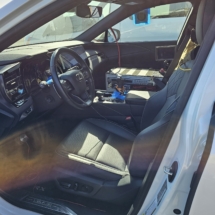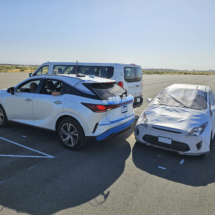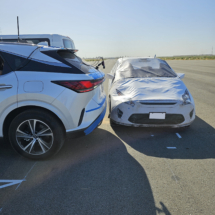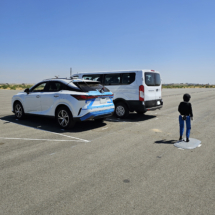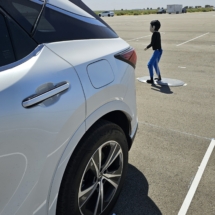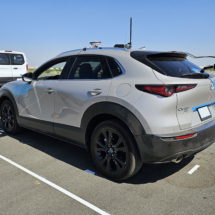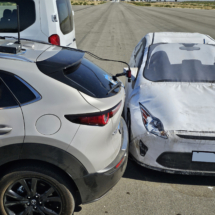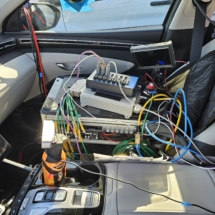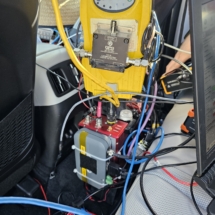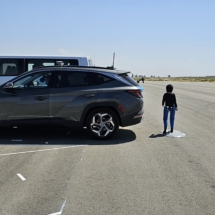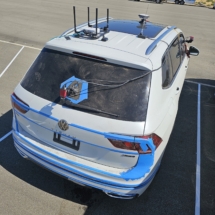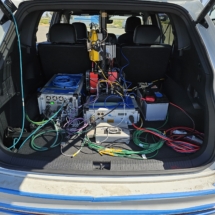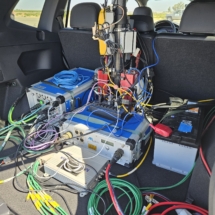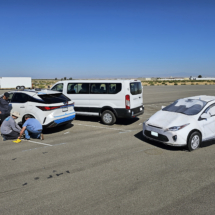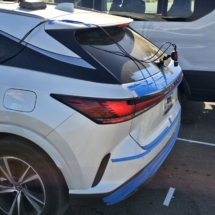PORTLAND, Ore., – New research from AAA shows that Reverse Automatic Emergency Braking (AEB) only works in certain driving situations. Reverse AEB is a driver assistance system that can automatically apply a car’s brakes when it detects a potential collision behind the vehicle when a driver is backing up.
AAA tested four vehicles equipped with reverse AEB with rear cross traffic mitigation in a selection of simulated backup collision scenarios to better understand how automakers are implementing these safety systems and how drivers can use these systems to avoid or lessen the severity of a collision.
Reverse automatic emergency braking systems can reduce rear-end collisions. Reverse AEB with rear cross traffic mitigation systems are designed to mitigate or prevent collisions with other vehicles, with some reverse AEB systems detecting rear cross-traffic and automatically applying brakes in response to other cars, pedestrians, cyclists or stationary objects.
Approximately 30% of new vehicles have Reverse AEB as standard or optional but not all of those Reverse AEB systems have the rear cross traffic function.
AAA Crash Test B-roll video can be found here: https://youtu.be/fTuIis9RaMQ and https://youtu.be/nDFIlUh9qvw
Photos from the testing are included below.
The AAA Testing:
AAA Engineers wanted to know how reverse AEB systems perform when
1) backing out of a parking space into the path of an oncoming vehicle with an adjacent parked vehicle blocking the view; and
2) encountering a stationary child pedestrian behind the vehicle.
“If you’re parked next to a large vehicle in a parking lot, it can be very difficult to see oncoming vehicles or other objects when you’re backing out of the parking space. That’s what researchers tested in the first scenario. In the second scenario, a dummy made to look like a child was placed behind the vehicles to see if the Reverse AEB systems would detect the dummy and stop the vehicles before hitting the dummy,” says Marie Dodds, public affairs director for AAA Oregon/Idaho.
The Results:
1) Reverse AEB systems automatically applied brakes in 65% of test runs and prevented a collision in 2.5% of test runs in the context of backing-up scenarios involving a subject vehicle crossing behind the test vehicle.
2) With the stationary child target behind the test vehicle, reverse (AEB) automatically applied brakes in 75% of test runs and prevented a collision in 50% of test runs.
“The results of our AAA testing show that Reverse Automatic Emergency Braking can prevent collisions in some situations. But there are also a number of situations where Reverse AEB does not work. The bottom line is that driver should not rely on Reverse AEB to prevent collisions when backing up, but should use the technology, along with rearview cameras and other sensors to enhance their awareness,” says Dodds.
Tips for Drivers:
Back up cautiously when an object obstructs the view, allowing the sensors to “see” cross traffic, giving the system more time to detect a potential collision and to bring the vehicle to a stop.
Realize that the Reverse AEB may not detect everything in your vehicle’s path.
Drivers should always be fully aware of their surroundings, and know how Reverse Automatic Emergency Braking systems work and the limitations these systems have. Drivers should not depend on Reverse AEB or other systems to prevent collisions. There is still no technology that works 100% of the time. It’s critical that drivers remain alert and engaged when behind the wheel.
It’s important to make sure that your vehicle’s Advanced Driver Assistance Systems (ADAS) are working properly and repaired accurately. Check out Fixing Advanced Vehicle Systems Makes Up Over One-Third of Repair Costs Following a Crash.
Industry Advice:
Testing standards for these systems are lacking in the United States but are crucial to ensure they function properly in real-world scenarios. It’s important to evaluate not only their functionality but also their ability to address different situations that may arise. Taking a balanced approach to testing can help ensure that these systems are safe and effective for all users.
Methodology:
In partnership with the Automobile Club of Southern California’s Automotive Research Center, AAA selected four vehicles for testing that were equipped with Reverse AEB systems with rear cross traffic mitigation. AAA chose to test small to midsize SUVs due to the popularity of these vehicles.
2023 Hyundai Tucson Hybrid Limited AWD
2023 Lexus RX 350 Premium
2023 Mazda CX-30 2.5 Turbo AWD Premium Plus Package
2023 Volkswagen Tiguan 2.0T SEL R-Line
Once vehicles were acquired, they were inspected and confirmed to be in as-new operating condition. Prior to testing, each vehicle except the Volkswagen was taken to a dealership where front-end alignments and ADAS sensor calibrations were performed per manufacturer specification. The Volkswagen Tiguan was provided by the manufacturer directly from the factory, and alignment and calibrations were not necessary per the provider.
Each vehicle was outfitted with instruments, cameras and brake pedal sensors.
Please refer to the full report for methodology details, including specific testing equipment and test track characteristics.
About AAA
Started in 1902 by automotive enthusiasts who wanted to chart a path for better roads in America and advocate for safe mobility, AAA has transformed into one of North America’s largest membership organizations. Today, AAA provides roadside assistance, travel, discounts, and financial and insurance services to enhance the life journey of over 64 million members across North America, including over 57 million in the United States. To learn more about all AAA offers or become a member, visit AAA.com.


